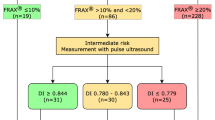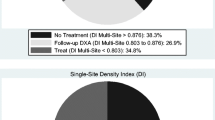Abstract
Summary
Due to the lack of diagnostics in primary health care, over 75 % of osteoporotic patients are not diagnosed. A new ultrasound method for primary health care is proposed. Results suggest applicability of ultrasound method for osteoporosis diagnostics at primary health care.
Introduction
We lack effective screening and diagnostics of osteoporosis at primary health care. In this study, a new ultrasound (US) method is proposed for osteoporosis diagnostics.
Methods
A total of 572 Caucasian women (age 20 to 91 years) were examined using pulse-echo US measurements in the tibia and radius. This method provides an estimate of bone mineral density (BMD), i.e. density index (DI). Areal BMD measurements at the femoral neck (BMDneck) and total hip (BMDtotal) were determined by using axial dual-energy X-ray absorptiometry (DXA) for women older than 50 years of age (n = 445, age = 68.8 ± 8.5 years). The osteoporosis thresholds for the DI were determined according to the International Society for Clinical Densitometry (ISCD). Finally, the FRAX questionnaire was completed by 425 participants.
Results
Osteoporosis was diagnosed in individuals with a T-score −2.5 or less in the total hip or femoral neck (n = 75). By using the ISCD approach for the DI, only 28.7 % of the subjects were found to require an additional DXA measurement. Our results suggest that combination of US measurement and FRAX in osteoporosis management pathways would decrease the number of DXA measurements to 16 % and the same treatment decisions would be reached at 85.4 % sensitivity and 78.5 % specificity levels.
Conclusions
The present results demonstrate a significant correlation between the ultrasound and DXA measurements at the proximal femur. The thresholds presented here with the application to current osteoporosis management pathways show promise for the technique to significantly decrease the amount of DXA referrals and increase diagnostic coverage; however, these results need to be confirmed in future studies.



Similar content being viewed by others
References
Reginster JY, Burlet N (2006) Osteoporosis: a still increasing prevalence. Bone 38(2 Suppl 1):S4–S9
Nguyen TV, Center JR, Eisman JA (2004) Osteoporosis: underrated, underdiagnosed and undertreated. Med J Aust 50:S18–S22
Kanis JA (1994) Assessment of fracture risk and its application to screening for postmenopausal osteoporosis: synopsis of a WHO report. WHO Study Group. Osteoporos Int 4(6):368–381
Johnell O, Kanis J (2005) Epidemiology of osteoporotic fractures. Osteoporos Int 16(Suppl 2):S3–S7
Keene GS, Parker MJ, Pryor GA (1993) Mortality and morbidity after hip fractures. BMJ 307(6914):1248–1250
Center JR, Nguyen TV, Schneider D, Sambrook PN, Eisman JA (1999) Mortality after all major types of osteoporotic fracture in men and women: an observational study. Lancet 353(9156):878–882
Kanis JA, McCloskey EV, Johansson H, Oden A, Melton LJ 3rd, Khaltaev N (2008) A reference standard for the description of osteoporosis. Bone 42(3):467–475
National Osteoporosis Foundation (2013) Clinician’s guide to prevention and treatment of osteoporosis. Washington, DC, National Osteoporosis Foundation
Compston J, Bowring C, Cooper A, Cooper C, Davies C, Francis R et al (2013) Diagnosis and management of osteoporosis in postmenopausal women and older men in the UK: National Osteoporosis Guideline Group (NOGG) update 2013. Maturitas 73:392–396
Osteoporosis [Internet]. Helsinki: The Finnish Medical Society Duodecim, Finnish Endocrine Society, Finnish Gynecological Association; 2014 [updated 24.04.2014; cited 30.5.2014]. Available from: http://www.kaypahoito.fi/web/kh/suositukset/suositus?id=hoi24065
Kanis JA, McCloskey EV, Johansson H, Cooper C, Rizzoli R, Reginster JY (2012) European guidance for the diagnosis and management of osteoporosis in postmenopausal women. Osteoporos Int 24(1):23–57
Cummins MN, Poku EK, Towler MR, O’Driscoll MO, Ralston SH (2011) Clinical risk factors for osteoporosis in Ireland and the UK: a comparison of FRAX and QFractureScores. Calcif Tissue Int 89(2):172–177
Langton CM, Palmer SB, Porter RW (1984) The measurement of broadband ultrasonic attenuation in cancellous bone. Eng Med 13(2):89–91
Nayak S, Olkin I, PhD, Liu H, Grabe M, Gould MK, Allen IE et al (2006) Meta-analysis: accuracy of quantitative ultrasound for identifying patients with osteoporosis. Ann Intern Med: 832–41
Damilakis J, Papadokostakis G, Perisinakis K, Maris T, Dimitriou P, Hadjipavlou A et al (2004) Discrimination of hip fractures by quantitative ultrasound of the phalanges and the calcaneus and dual X-ray absorptiometry. Eur J Radiol 50(3):268–272
Wang SF, Chang CY, Shih C, Teng MMH (1997) Evaluation of tibial cortical bone by ultrasound velocity in oriental females. Br J Radiol 70(839):1126–1130
Karjalainen J, Riekkinen O, Töyräs J, Kröger H, Jurvelin JS (2008) Ultrasonic assessment of cortical bone thickness in vitro and in vivo. IEEE Trans Ultrason Ferroelectr Freq Control 55(10):2191–2197
Wear KA (2003) Autocorrelation and cepstral methods for measurement of tibial cortical thickness. IEEE Trans Ultrason Ferroelectr Freq Control 50(6):655–660
Karjalainen J, Riekkinen O, Töyräs J, Hakulinen M, Kröger H, Rikkonen T et al (2012) Multi-site bone ultrasound measurements in elderly women with and without previous hip fractures. Osteoporos Int 23(4):1287
Hans DB, Shepherd JA, Schwartz EN, Reid DM, Blake GM, Fordham JN et al (2008) Peripheral dual-energy X-ray absorptiometry in the management of osteoporosis: the 2007 ISCD Official Positions. J Clin Densitom 11(1):188–206
Blake GM, Chinn DJ, Steel SA, Patel R, Panayiotou E, Thorpe J et al (2005) A list of device-specific thresholds for the clinical interpretation of peripheral x-ray absorptiometry examinations. Osteoporos Int 16:2149–2156
Krieg MA, Barkmann R, Gonnelli S, Stewart A, Bauer DC, Barquero L et al (2008) Quantitative ultrasound in the management of osteoporosis: the 2007 ISCD official positions. J Clin Densitom 11(1):163–187
Honkanen R, Tuppurainen M, Kröger H, Alhava E, Saarikoski S (1998) Relationships between risk factors and fractures differ by type of fracture: a population based study of 12,192 perimenopausal women. Osteoporos Int 8(1):25–31
Gluer CC, Blake GM, Lu Y, Blunt A, Jergas M, Genant HK (1995) Accurate assessment of precision errors: how to measure the reproducibility of bone densitometry techniques. Osteoporos Int 5:262
Shepherd JA, Lu Y, Wilson K, Fuerst T, Genant HK, Hangartner TN et al (2006) Cross-calibration and minimum precision standards for dual-energy X-ray absorptiometry: the 2005 ISCD Official Positions. J Clin Densitom 9(1):31–36
Patel R, Blake GM, Fordham JN, McCrea D, Ryan P (2011) Peripheral X-ray absorptiometry in the management of osteoporosis. National Osteoporosis Society - Practical Guides
Author information
Authors and Affiliations
Corresponding author
Ethics declarations
Conflicts of interest
Janne P Karjalainen owns stocks and is an employee at Bone Index Finland Ltd. Ossi Riekkinen owns stocks and is an employee at Bone Index Finland Ltd. Juha Töyräs has no disclosures. Jukka S Jurvelin owns stocks at Bone Index Finland Ltd. Heikki Kröger owns stocks at Bone Index Finland Ltd.
Rights and permissions
About this article
Cite this article
Karjalainen, J.P., Riekkinen, O., Töyräs, J. et al. New method for point-of-care osteoporosis screening and diagnostics. Osteoporos Int 27, 971–977 (2016). https://doi.org/10.1007/s00198-015-3387-4
Received:
Accepted:
Published:
Issue Date:
DOI: https://doi.org/10.1007/s00198-015-3387-4




